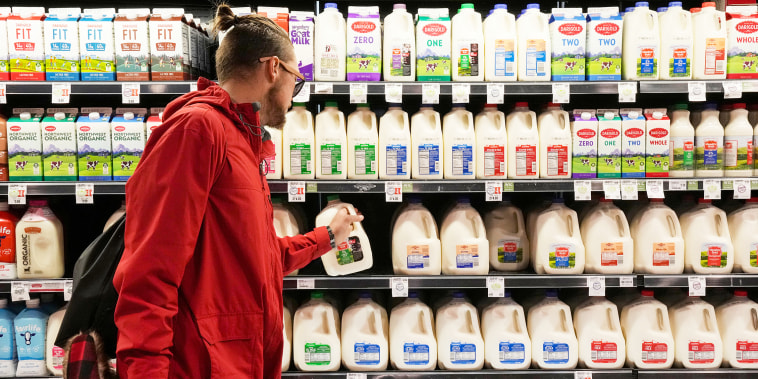
Inflation cooled to 5% in March, but consumer pain is set to linger
Consumer prices climbed 5% in March, the Bureau of Labor Statistics reported Wednesday, down from 6% in February.
The latest inflation reading represents the ninth-straight month of easing price growth on an annual basis, and is down from a 9% high last June. On a month-over-month basis, prices increased 0.1% — the lowest reading since last July.
But it’s still well above the Federal Reserve’s 2% target. Among the key categories still seeing outsized price growth are food, which climbed 8.5% from March 2022 to March 2023, and rent, which hit 8.3% growth, its largest-ever 12-month increase.
As a result, cooling inflation won’t prove much solace to consumers, who can still expect to feel the pinch in their pocketbooks for a while longer.
A customer at a grocery store in Salt Lake City.George Frey / Bloomberg via Getty Images file
Because inflation numbers are closely tied to the Federal Reserve’s decisions about how high interest rates should be, a majority of investors are betting the Fed will raise rates by 0.25% again at its next meeting May 3.
Analysts say some of the key drivers of the post-pandemic spike in inflation, like supply chain issues and the elevated food and energy prices spurred in part by the war in Ukraine, are abating. But the flames of inflation are nevertheless being fanned by a still-hot job market, which has added 1 million positions in 2023.
It’s an unfortunate trade-off: Workers who feel secure about their jobs are comfortable spending, which creates demand in the economy that can drive price surges.
By raising interest rates, the Federal Reserve hopes to make investing, borrowing and ultimately hiring more costly for businesses.
‘There’s an imbalance in demand and supply,’ said Greg McBride, Bankrate’s senior vice president and chief financial analyst. ‘Now, that imbalance still stems from an outsized level of demand. Unemployment is at a 50-year low, and spending is quite strong, and it’s that demand that the Fed is aiming to address by raising interest rates.’
In a recent note to clients, Seema Shah, the chief global strategist of Principal Asset Management, said U.S. inflation is expected to decelerate further through this year, ‘but only very slowly.’
‘Slower economic activity and a looser labor market’ — most likely meaning an unemployment rate higher than the current 3.5% — ‘will be necessary to fade these pressures,’ Shah said.
An L.A. apartment for rent last fall. Rents rose by 8.3% from March 2022 to March 2023, the largest-ever 12-month increase. Allison Dinner / Getty Images file
Cost of food and shelter remain stubbornly high
Food and rent are among the categories that continue to have the largest price increases. In February, food prices climbed about 10%, continuing a run of double-digit 12-month increases that stretch back to May.
The same month, rents had their largest one-month increase on record, climbing 8.2%. Rent data is considered a ‘lagging’ indicator, meaning surveys are slower to capture real-time changes because most leases are at least 12 months long. Other data from Realtor.com shows rent growth peaked sometime around winter 2021-22.
Indeed, prices are cooling substantially in other areas of the economy. While gas prices have climbed more than 13 cents over the past month, to $3.61 a gallon, they are still below the $4 levels of a year ago.
Wage growth is slowing
Meanwhile, wage growth has begun to show significant declines after it experienced bumps during the pandemic. According to data published by Goldman Sachs, workers’ earnings are growing at less than 5% per quarter, down from as much as 8% in 2021. And wage growth for lower-paid workers, represented by leisure and hospitality positions, has declined to less than 6% after having surged to about 18% in the winter of 2021-22.
“We see the slowdown in wage growth alongside a further decline in the unemployment rate as supportive of our long-standing view that much of the peak wage growth overshoot was driven by temporary factors” — mostly pandemic-related causes like stimulus checks, reduced labor supply and energy price spikes that led workers to demand higher pay, Goldman Sachs economist David Mericle wrote in a note to clients Friday.
“All of these have fully or partially faded on their own and appear to have solved much of the problem of lowering wage growth to the 3.5% pace that we estimate would be compatible with 2% inflation,’ Mericle continued.
As a result, he said, there is less urgency for the Fed to continue aggressively hiking interest rates.
But McBride of Bankrate said that even as inflation continues to slow, it won’t reverse outright. Only in rare instances — and not even during some recessions — do prices decline on an annual basis.
The bottom line: The higher prices that have become a hallmark of the post-pandemic U.S. economy are here to stay.
‘The hoped-for moderation in inflation is not something that means prices will fall. It just means they don’t rise as fast,’ McBride said.
‘The inflation we’ve seen over the past couple of years has increased household expenses and essentially set a new base, and those expenses are not going to fall in a broad-based way. They just might not go up as fast.’
